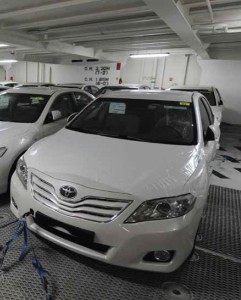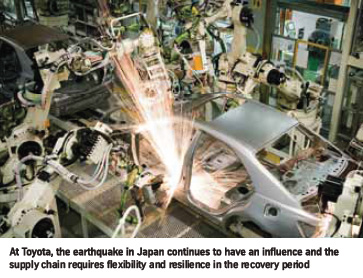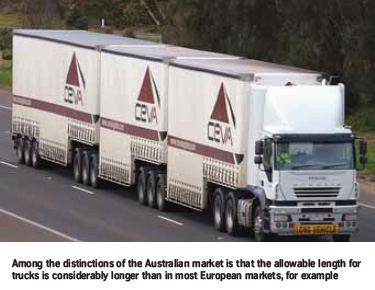Confidence is returning to the automotive industry in Australia after a period of slump but challenges such as infrastructure investment and supply chain flexibility need to be met, writes Andrew Williams.

In the wake of the global financial crisis, the Australian automotive industry suffered in much the same way as the rest of the world–plummeting levels of demand and sales were accompanied by a deep drop in consumer confidence. Over the medium term, car production in Australia has almost halved from a decade ago and the forecast is for very little growth going forward. But there are signs that the sector has begun to turn a corner–the general view among industry observers is that demand, volumes and sales in the Australian automotive sector will rise throughout the period 2011-12 (see tables).
According to Barry Budge, corporate manager–supply continuity at Toyota Australia, while the market is down 3.2% to the end of April, it remains healthy in terms of recent history and is still on track to top 1m units in sales this year. Several major factors continue to influence market prospects in the region, including the impact of the Queensland floods, the Japan earthquake and tsunami, and that Australians continue to be cautious in borrowing and spending. “On the plus side, the economic outlook is generally favourable and industries directly affected by the floods are expected to recover and lift production–as well as demand for vehicles–in the months ahead,” says Budge.
“Further positive news is the earlier than expected return to normal production throughout the Toyota world following the Japan earthquake and tsunami,” he adds. David Dudek, director, automotive–Asia Pacific at Ceva Logistics expects the upward trend to continue over the next few years, accompanied by a gradual rise in consumer confidence. Adding to this positive outlook, the Australian government has also announced plans to continue to deliver a stimulus package for small and medium enterprises. “This move will add to consumer confidence and is expected to contribute to additional car sales,” says Dudek.

The Australian industry, however, still faces a number of challenges. Currently, only Ford, GM/Holden and Toyota produce cars in Australia.
According to Benjamin Asher, business manager at JD Power and Associates, Ford has recently cut production in half as demand wanes for the large sedans it produces there. With no export programme to support volumes, Asher questions the long-term viability of Ford production in Australia. Perhaps foremost among the Australian industry’s challenges is increased competition from overseas, particularly China. Toyota, and has also recently initiated an export programme to the US. However, with China just starting to look at exports, and with GM having such large-scale operations there, one has to consider whether they too would consider importing Chinese-made vehicles,” Asher adds.
With the traditional powerhouses of GM/Holden and Ford losing steam, Asher predicts increased fragmentation in the market as a whole, with more Chinese brands making inroads. Chery, Geely and Great Wall all now sell in Australia and MG and JAC will begin next year–with many more announcements expected over the coming year.
In 2010 Great Wall trebled car sales, largely by pursuing a strategy of pricing vehicles lower than other similar vehicles on the market–but with a higher specification. Australia is therefore emerging as an ideal test market for companies wishing to pursue sales in Europe and North America. But the increase in the number of competing low-margin brands could impact the supply chain for both vehicle distribution and parts and service. With imports expected to rise, Asher says that manufacturers will have to look to exports. The Australian industry will also see ongoing disruption from the Japanese earthquake. “Local manufacturers face tough competition from importers, with falling production at Ford and flagging sales of Falcon, Territory and Toyota due to issues following the Japan earthquake and tsunami,” says Robert Chionna, commercial manager for automotive at DHL Global Forwarding.
At Toyota, supply constraints resulting from the earthquake continue to loom large, and any subsequent recovery is likely  to demand flexibility and resilience in the supply chain. “A significant amount of flexibility is required to support our customers and dealer network. [We are] working very closely with [our] logistics suppliers to ensure a rapid return to full capacity during the recovery,” says Malcolm Gillies, corporate manager for vehicle logistics at Toyota Australia. Gillies also anticipates an increased focus on projects aimed at tracking and limiting carbon emissions stemming from the likely introduction of a government carbon price policy. The development of a robust methodology to track carbon usage will remain an important priority as the company gathers detailed and relevant data to target its much publicised carbon reduction initiatives.
to demand flexibility and resilience in the supply chain. “A significant amount of flexibility is required to support our customers and dealer network. [We are] working very closely with [our] logistics suppliers to ensure a rapid return to full capacity during the recovery,” says Malcolm Gillies, corporate manager for vehicle logistics at Toyota Australia. Gillies also anticipates an increased focus on projects aimed at tracking and limiting carbon emissions stemming from the likely introduction of a government carbon price policy. The development of a robust methodology to track carbon usage will remain an important priority as the company gathers detailed and relevant data to target its much publicised carbon reduction initiatives.
“We will continue to work closely with our logistics partners to not only investigate and introduce alternative fuel technologies and increased fleet-efficiency, but conduct a full review of our transport route and mode-profile to maximise load-efficiency,” he explains.
On top of increased global competition and more stringent environmental requirements, another major challenge stems from the need to adapt to the market changes resulting from the rising Australian dollar, which makes Australian vehicles more expensive to export and imported vehicles cheaper. “The appreciation of the dollar drives a whole heap of different challenges for imports and exports, and if there are potentially more imports, this drives numerous changes that the industry must adapt to,” says Trevor Boys, logistics manager at Holden.
Logistics challenges
Some observers suggest that the industry-wide collaboration of all stakeholders in the Australian automotive supply chain, including OEMs, suppliers, unions and government should be prioritised.
“The role of each stakeholder needs to be considered by all parties to ensure alignment of strategies, and firm action plans need to be agreed and implemented with speed,” says Budge. “[The] synchronisation of all the elements and partners in the supply chain will be critical in building efficiency and robustness in the entire supply chain to ensure its responsiveness to rapidly changing market conditions,” agrees Gillies.
 Beyond increased partnership and collaboration, mid- to long-term improvements in performance are also likely to demand higher levels of investment across the sector. “The Australian logistics sector will need to focus on making sure there is sufficient up-front investment in key infrastructure to ensure there is the capacity to support operations,” says Boys.
Beyond increased partnership and collaboration, mid- to long-term improvements in performance are also likely to demand higher levels of investment across the sector. “The Australian logistics sector will need to focus on making sure there is sufficient up-front investment in key infrastructure to ensure there is the capacity to support operations,” says Boys.
Much of that investment is likely to come from the Australian government, which plans to spend some A$36.2 billion ($38.5 billion) on road and rail infrastructure on a programme that commenced in 2008. For Gillies, such investment is vital to promote the use of rail as an alternative to long-haul vehicle freight and to increase its viability and competitiveness.
“There is a need to increase national compatibility and efficiency in order to bring rail usage in line with global best-practice,” he explains. “We anticipate greater focus on this mode with increased road congestion and pressure on reducing CO2 emissions,” he adds.
Recently, Toyota Australia has applied significant focus on Estimated Time of Arrive (ETA) accuracy, culminating in what Gilles describes as a “major capability enhancement” that is currently in a pilot phase, prior to a national roll-out planned by the end of 2011. Enhancements are being made to processing and plant facilities, to ensure the more accurate and timely planning of transport loads, as well as to the IT infrastructure–providing more accurate and accessible communication to the company’s customers.
“Introducing greater flexibility for meeting customer demands, whilst maintaining ETA accuracy and minimising lead time will be a significant focus over the next two-year horizon for Toyota Australia,” he says.
“Wharf capacity and infrastructure development of dedicated automotive facilities will also be a major focus in the mid-term. Securing capacity and long-term tenure is still a major concern for the industry. This is also compounded by limited options and competition throughout the Australian supply chain, which is a likely reflection of the relatively small industry size,” Gillies adds.
In a big country
Perhaps unsurprisingly, Australia’s remote location can make it more difficult to integrate operations with global supply  chains–calling on the domestic logistics sector to face up to some fairly unique challenges.
chains–calling on the domestic logistics sector to face up to some fairly unique challenges.
“The suppliers we work with at Holden need to operate in multiple time zones and the logistics operations personnel tend to lose a lot of sleep!” says Holden’s Boys. “Long lead times remain a constant challenge and the industry needs to be very responsive and flexible to meet market demand.” For Dudek, the vast size of the land and the distances between major populated centres present several challenges in delivering market to market product flows.
“To overcome these challenges, Ceva has developed clear frameworks, methodologies and solutions to work in partnership with customers to review and address their supply chains to deliver savings in terms of cost and efficiencies. This includes overcoming pressures such as ever shortening customer lead times,” says Dudek. Besides its remoteness, Australia’s extreme weather, large size and difficult terrain create further headaches for the internal automotive logistics market. According to Boys, the combination of a relatively small population with such vast distances can make it difficult to fully utilise available assets. “Logistics service providers need to develop shared services as much as possible to overcome these challenges and drive down cost. It’s a waste to have empty trucks driving past each other on Australia’s lengthy highways,” he says.
At Toyota Australia, some 80% of the company’s total logistics volume goes to metropolitan dealers. However, challenges faced in dealing with the 20% of volume destined for more remote locations have led the company to recognise the need for transport services to be shared among brands to increase trailer utilisation and reduce lead-time.
“The large size of Australia also results in increased shipping costs for imported vehicles and multiple port calls for relatively small volumes [on a global scale],” says Gillies. “Unlike the US or Europe where a ship would unload all its cargo at one port, ours may call in at up to five ports on one journey. Limitation in rail infrastructure also means that we rely more heavily on the road network, making consolidation of port facilities less viable.”
Extreme weather events, such as the recent Queensland floods and Cyclone Yasi, which affected large parts of Queensland in January 2011, can also affect local supply chains at any given time through disruption to road, rail and sea transport services.
Building on core strengths
Following a prolonged slump, the Australian automotive industry appears to be entering a period of limited expansion, some of which should be attributed to a range of competitive advantages, including the existence of a skilled and innovative multicultural workforce, political stability and sound financial systems, as well as a combination of abundant natural resources and a mature consumer market viewed by many in the industry as ideal for trialling new products. “All of these factors add to Australia’s competitive advantage issues and should be promoted by Australian industry,” says Budge.
Looking ahead, there are a number of ways in which these regional advantages could be employed in navigating the rocky road ahead. For example, Dudek suggests that there is now a great opportunity for local OEMs and vehicle importers to improve their supply chain.
“In the major urban areas of Sydney and Melbourne, car dealers are often clustered together, providing an ideal platform from which to share supply infrastructure, [including] equipment utilisation, carrier allocation and optimal packaging to leverage repeatable and proven processes to drive service improvements, enhance flows, push costs down [to help] the environment,” Dudek says.
Increased collaboration between land-locked metropolitan dealers is another potential strategy that could improve the prospects of a sector that may face an uphill struggle to find capacity for increasing market volumes. “Greater coordination at the dealer level, particularly around centralised stock-holding and transportation of dealer to dealer stock moves is an area with significant scope for improved efficiency,” says Gillies. “Improvements to rail, road and port infrastructure [are also] needed, as well as certainty around carbon price policy,” he adds.
Improvements in the maritime and rail infrastructure are also important and more vehicles and components are expected to be coming to the ports rather than the traditional vehicle production hubs of Adelaide and Melbourne. “Fast entry and exit of shipping from Australian ports and improved road and rail infrastructure to ensure safe and speedy transport of goods [is important],” says Budge. More ambitiously, JD Power’s Asher argues that there is now an opportunity for Australia to position itself as a design and technology hub for Asia, supporting operations in China, India and the Asean region.
“Though Toyota is increasingly relying on Thailand production for Australia, the Australian teams support Thailand in design,” he says.
While Australia faces challenges in its bid to ensure growth, a combination of good links with regional supply chains, planned increases in infrastructure investment and an existing range of strong historical competitive advantages look set to improve prospects over the medium to long term.




































